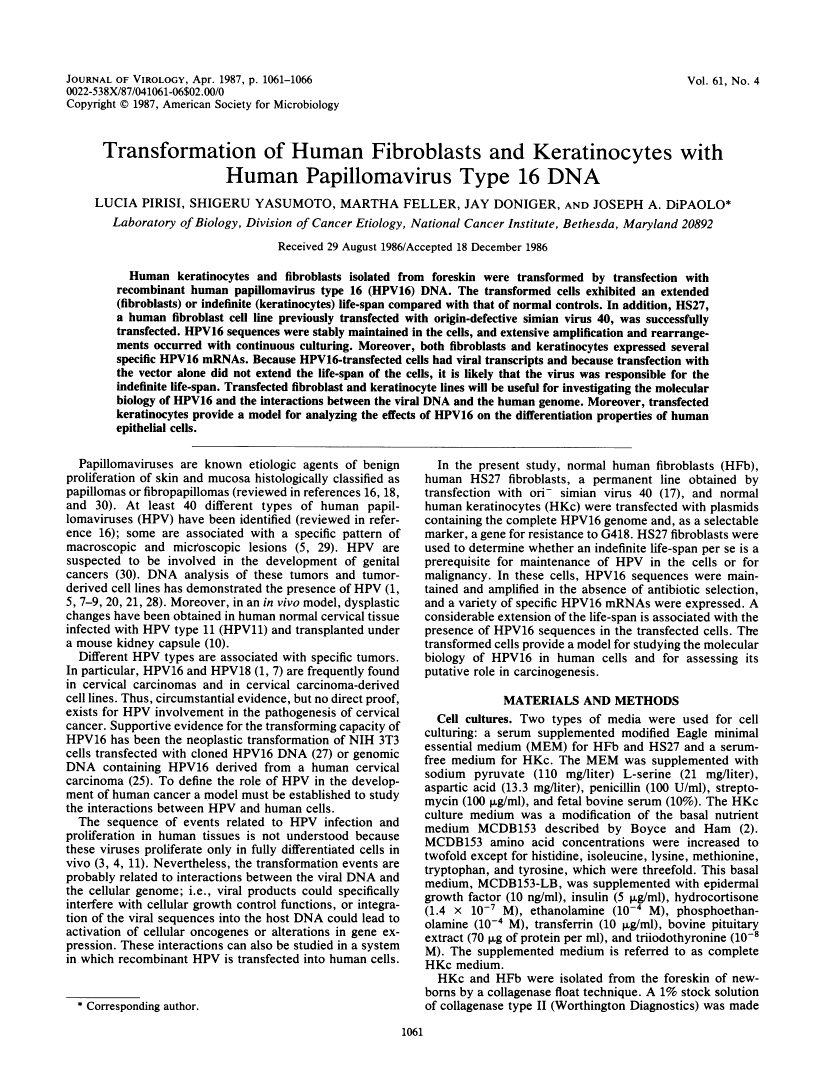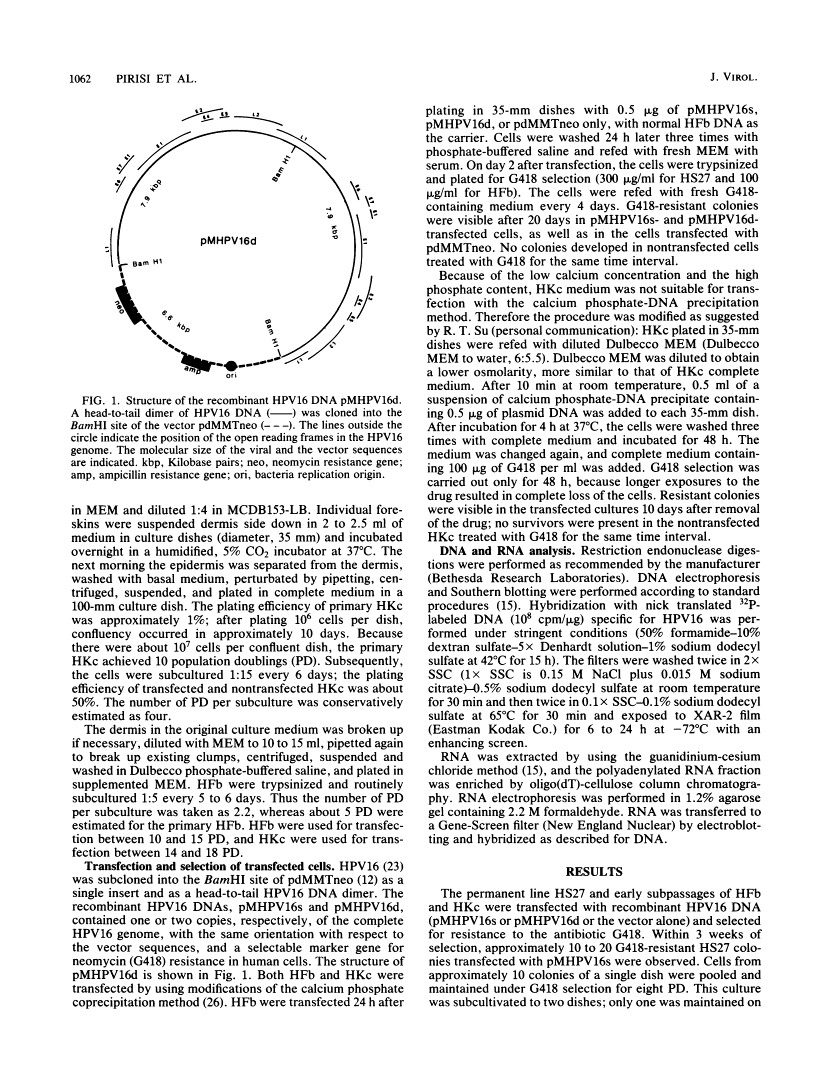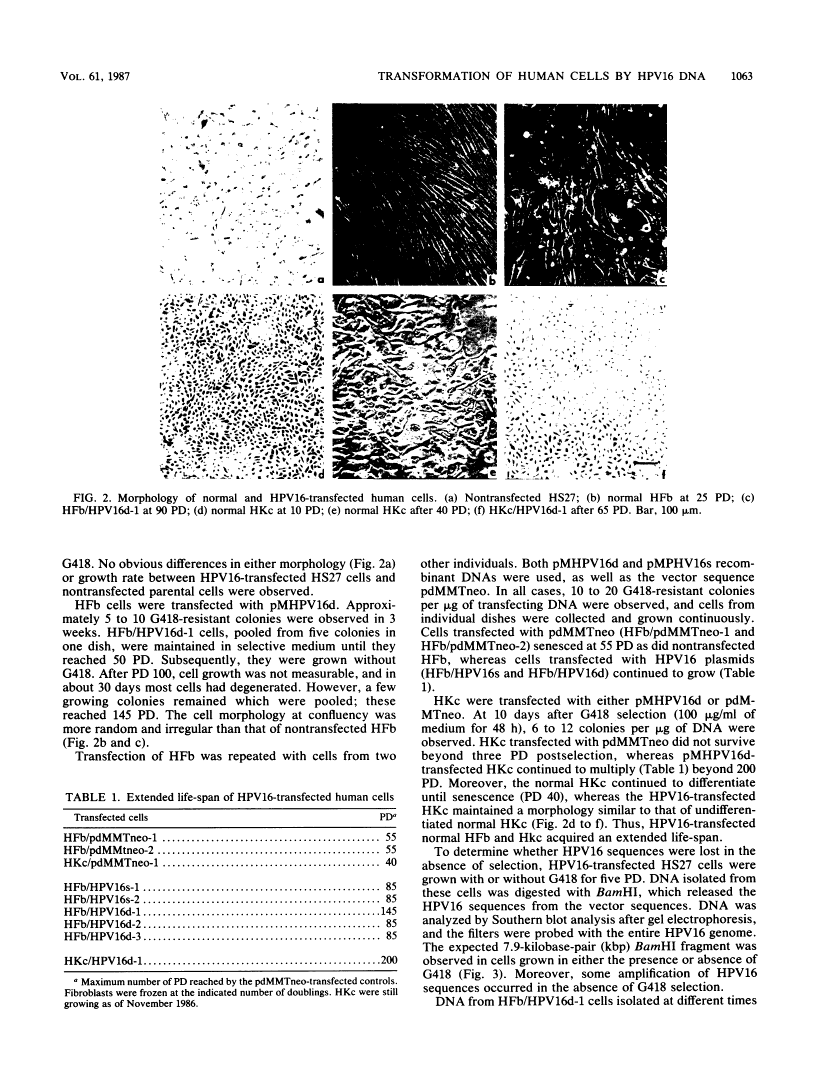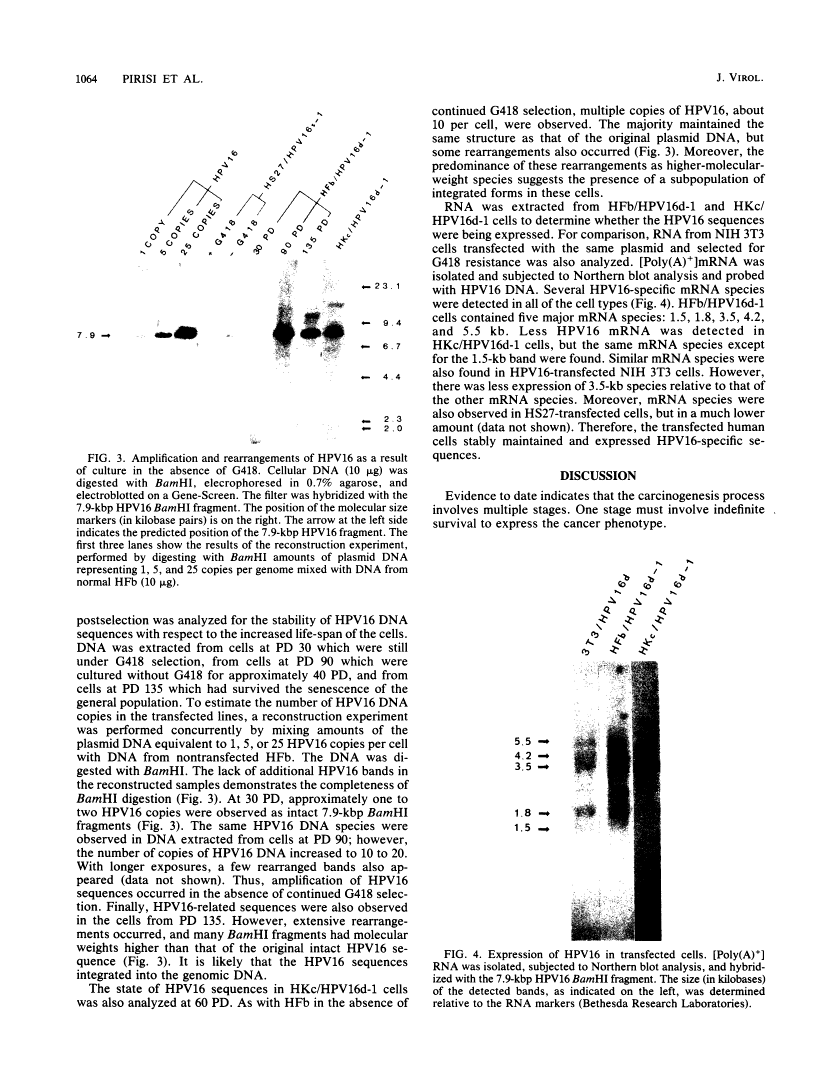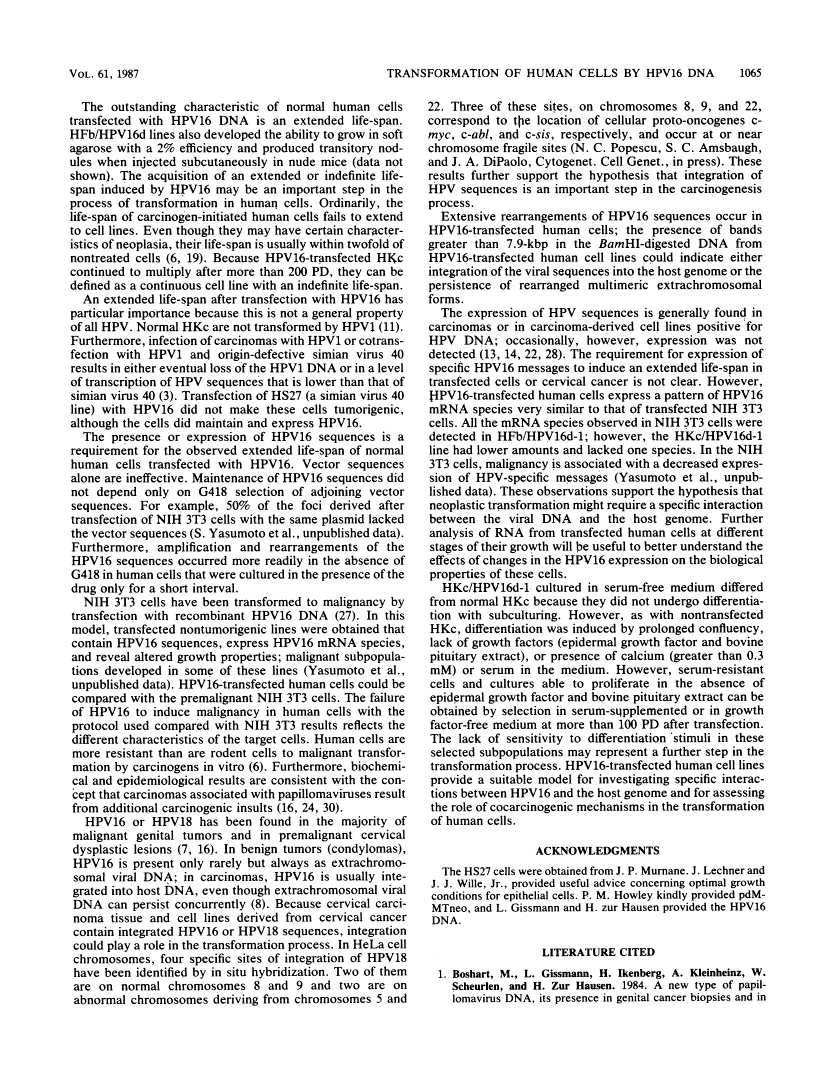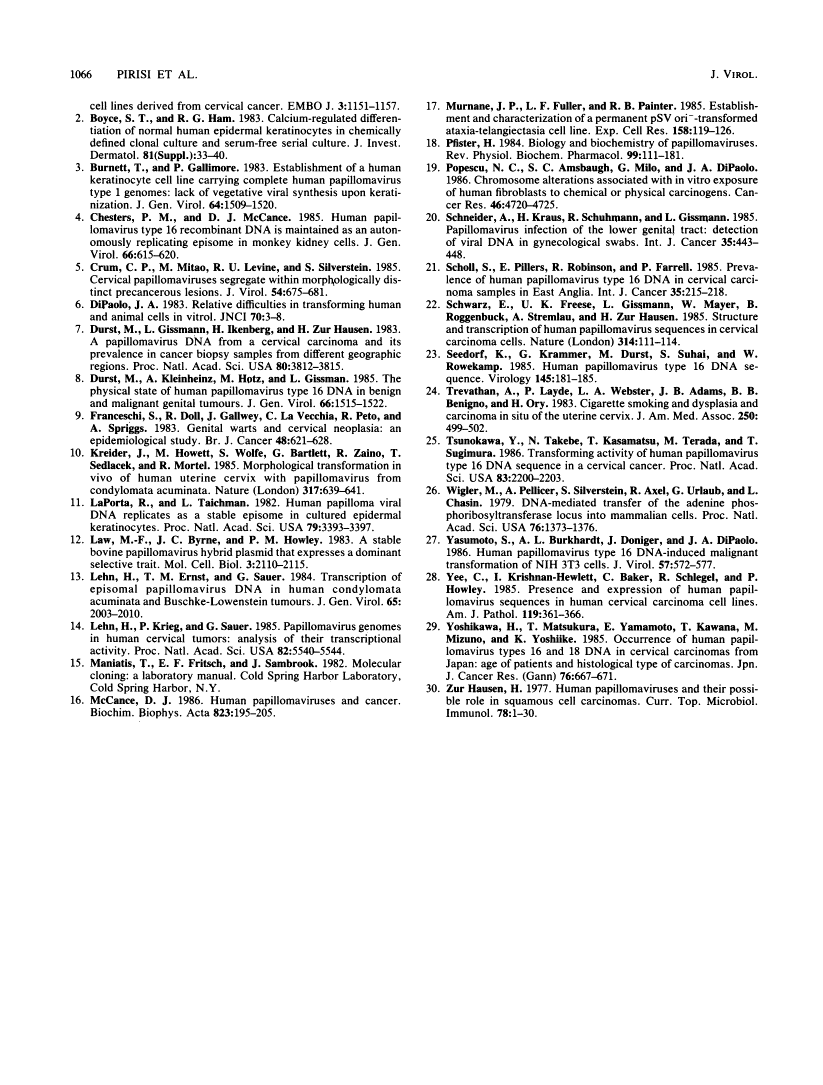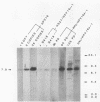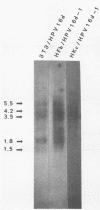Abstract
Free full text

Transformation of human fibroblasts and keratinocytes with human papillomavirus type 16 DNA.
Abstract
Human keratinocytes and fibroblasts isolated from foreskin were transformed by transfection with recombinant human papillomavirus type 16 (HPV16) DNA. The transformed cells exhibited an extended (fibroblasts) or indefinite (keratinocytes) life-span compared with that of normal controls. In addition, HS27, a human fibroblast cell line previously transfected with origin-defective simian virus 40, was successfully transfected. HPV16 sequences were stably maintained in the cells, and extensive amplification and rearrangements occurred with continuous culturing. Moreover, both fibroblasts and keratinocytes expressed several specific HPV16 mRNAs. Because HPV16-transfected cells had viral transcripts and because transfection with the vector alone did not extend the life-span of the cells, it is likely that the virus was responsible for the indefinite life-span. Transfected fibroblast and keratinocyte lines will be useful for investigating the molecular biology of HPV16 and the interactions between the viral DNA and the human genome. Moreover, transfected keratinocytes provide a model for analyzing the effects of HPV16 on the differentiation properties of human epithelial cells.
Full text
Full text is available as a scanned copy of the original print version. Get a printable copy (PDF file) of the complete article (1.6M), or click on a page image below to browse page by page. Links to PubMed are also available for Selected References.
Images in this article
Selected References
These references are in PubMed. This may not be the complete list of references from this article.
- Burnett TS, Gallimore PH. Establishment of a human keratinocyte cell line carrying complete human papillomavirus type 1 genomes: lack of vegetative viral DNA synthesis upon keratinization. J Gen Virol. 1983 Jul;64(Pt 7):1509–1520. [Abstract] [Google Scholar]
- Chesters PM, McCance DJ. Human papillomavirus type 16 recombinant DNA is maintained as an autonomously replicating episome in monkey kidney cells. J Gen Virol. 1985 Mar;66(Pt 3):615–620. [Abstract] [Google Scholar]
- Crum CP, Mitao M, Levine RU, Silverstein S. Cervical papillomaviruses segregate within morphologically distinct precancerous lesions. J Virol. 1985 Jun;54(3):675–681. [Europe PMC free article] [Abstract] [Google Scholar]
- DiPaolo JA. Relative difficulties in transforming human and animal cells in vitro. J Natl Cancer Inst. 1983 Jan;70(1):3–8. [Abstract] [Google Scholar]
- Dürst M, Gissmann L, Ikenberg H, zur Hausen H. A papillomavirus DNA from a cervical carcinoma and its prevalence in cancer biopsy samples from different geographic regions. Proc Natl Acad Sci U S A. 1983 Jun;80(12):3812–3815. [Europe PMC free article] [Abstract] [Google Scholar]
- Dürst M, Kleinheinz A, Hotz M, Gissmann L. The physical state of human papillomavirus type 16 DNA in benign and malignant genital tumours. J Gen Virol. 1985 Jul;66(Pt 7):1515–1522. [Abstract] [Google Scholar]
- Franceschi S, Doll R, Gallwey J, La Vecchia C, Peto R, Spriggs AI. Genital warts and cervical neoplasia: an epidemiological study. Br J Cancer. 1983 Nov;48(5):621–628. [Europe PMC free article] [Abstract] [Google Scholar]
- Kreider JW, Howett MK, Wolfe SA, Bartlett GL, Zaino RJ, Sedlacek T, Mortel R. Morphological transformation in vivo of human uterine cervix with papillomavirus from condylomata acuminata. Nature. 1985 Oct 17;317(6038):639–641. [Abstract] [Google Scholar]
- LaPorta RF, Taichman LB. Human papilloma viral DNA replicates as a stable episome in cultured epidermal keratinocytes. Proc Natl Acad Sci U S A. 1982 Jun;79(11):3393–3397. [Europe PMC free article] [Abstract] [Google Scholar]
- Law MF, Byrne JC, Howley PM. A stable bovine papillomavirus hybrid plasmid that expresses a dominant selective trait. Mol Cell Biol. 1983 Nov;3(11):2110–2115. [Europe PMC free article] [Abstract] [Google Scholar]
- Lehn H, Ernst TM, Sauer G. Transcription of episomal papillomavirus DNA in human condylomata acuminata and Buschke-Löwenstein tumours. J Gen Virol. 1984 Nov;65(Pt 11):2003–2010. [Abstract] [Google Scholar]
- Lehn H, Krieg P, Sauer G. Papillomavirus genomes in human cervical tumors: analysis of their transcriptional activity. Proc Natl Acad Sci U S A. 1985 Aug;82(16):5540–5544. [Europe PMC free article] [Abstract] [Google Scholar]
- McCance DJ. Human papillomaviruses and cancer. Biochim Biophys Acta. 1986;823(3):195–205. [Abstract] [Google Scholar]
- Murnane JP, Fuller LF, Painter RB. Establishment and characterization of a permanent pSV ori--transformed ataxia-telangiectasia cell line. Exp Cell Res. 1985 May;158(1):119–126. [Abstract] [Google Scholar]
- Pfister H. Biology and biochemistry of papillomaviruses. Rev Physiol Biochem Pharmacol. 1984;99:111–181. [Abstract] [Google Scholar]
- Popescu NC, Amsbaugh SC, Milo G, DiPaolo JA. Chromosome alterations associated with in vitro exposure of human fibroblasts to chemical or physical carcinogens. Cancer Res. 1986 Sep;46(9):4720–4725. [Abstract] [Google Scholar]
- Schneider A, Kraus H, Schuhmann R, Gissmann L. Papillomavirus infection of the lower genital tract: detection of viral DNA in gynecological swabs. Int J Cancer. 1985 Apr 15;35(4):443–448. [Abstract] [Google Scholar]
- Scholl SM, Pillers EM, Robinson RE, Farrell PJ. Prevalence of human papillomavirus type 16 DNA in cervical carcinoma samples in East Anglia. Int J Cancer. 1985 Feb 15;35(2):215–218. [Abstract] [Google Scholar]
- Schwarz E, Freese UK, Gissmann L, Mayer W, Roggenbuck B, Stremlau A, zur Hausen H. Structure and transcription of human papillomavirus sequences in cervical carcinoma cells. Nature. 1985 Mar 7;314(6006):111–114. [Abstract] [Google Scholar]
- Seedorf K, Krämmer G, Dürst M, Suhai S, Röwekamp WG. Human papillomavirus type 16 DNA sequence. Virology. 1985 Aug;145(1):181–185. [Abstract] [Google Scholar]
- Trevathan E, Layde P, Webster LA, Adams JB, Benigno BB, Ory H. Cigarette smoking and dysplasia and carcinoma in situ of the uterine cervix. JAMA. 1983 Jul 22;250(4):499–502. [Abstract] [Google Scholar]
- Tsunokawa Y, Takebe N, Kasamatsu T, Terada M, Sugimura T. Transforming activity of human papillomavirus type 16 DNA sequence in a cervical cancer. Proc Natl Acad Sci U S A. 1986 Apr;83(7):2200–2203. [Europe PMC free article] [Abstract] [Google Scholar]
- Wigler M, Pellicer A, Silverstein S, Axel R, Urlaub G, Chasin L. DNA-mediated transfer of the adenine phosphoribosyltransferase locus into mammalian cells. Proc Natl Acad Sci U S A. 1979 Mar;76(3):1373–1376. [Europe PMC free article] [Abstract] [Google Scholar]
- Yasumoto S, Burkhardt AL, Doniger J, DiPaolo JA. Human papillomavirus type 16 DNA-induced malignant transformation of NIH 3T3 cells. J Virol. 1986 Feb;57(2):572–577. [Europe PMC free article] [Abstract] [Google Scholar]
- Yee C, Krishnan-Hewlett I, Baker CC, Schlegel R, Howley PM. Presence and expression of human papillomavirus sequences in human cervical carcinoma cell lines. Am J Pathol. 1985 Jun;119(3):361–366. [Europe PMC free article] [Abstract] [Google Scholar]
- Yoshikawa H, Matsukura T, Yamamoto E, Kawana T, Mizuno M, Yoshiike K. Occurrence of human papillomavirus types 16 and 18 DNA in cervical carcinomas from Japan: age of patients and histological type of carcinomas. Jpn J Cancer Res. 1985 Aug;76(8):667–671. [Abstract] [Google Scholar]
- zur Hausen H. Human papillomaviruses and their possible role in squamous cell carcinomas. Curr Top Microbiol Immunol. 1977;78:1–30. [Abstract] [Google Scholar]
Associated Data
Articles from Journal of Virology are provided here courtesy of American Society for Microbiology (ASM)
Full text links
Read article at publisher's site: https://doi.org/10.1128/jvi.61.4.1061-1066.1987
Read article for free, from open access legal sources, via Unpaywall:
https://jvi.asm.org/content/jvi/61/4/1061.full.pdf
Free to read at jvi.asm.org
http://jvi.asm.org/cgi/content/abstract/61/4/1061
Free after 4 months at jvi.asm.org
http://jvi.asm.org/cgi/reprint/61/4/1061
Citations & impact
Impact metrics
Article citations
Establishing and characterizing human stem cells from the apical papilla immortalized by hTERT gene transfer.
Front Cell Dev Biol, 11:1158936, 22 May 2023
Cited by: 1 article | PMID: 37283947 | PMCID: PMC10239932
Preventing Persistence of HPV Infection with Natural Molecules.
Pathogens, 12(3):416, 06 Mar 2023
Cited by: 8 articles | PMID: 36986338 | PMCID: PMC10056139
Review Free full text in Europe PMC
Human Proximal Tubule Epithelial Cells (HK-2) as a Sensitive In Vitro System for Ochratoxin A Induced Oxidative Stress.
Toxins (Basel), 13(11):787, 06 Nov 2021
Cited by: 5 articles | PMID: 34822571
The Marine Natural Product Manzamine A Inhibits Cervical Cancer by Targeting the SIX1 Protein.
J Nat Prod, 83(2):286-295, 05 Feb 2020
Cited by: 16 articles | PMID: 32022559 | PMCID: PMC7161578
Review Free full text in Europe PMC
piggyBac Transposon-Based Immortalization of Human Deciduous Tooth Dental Pulp Cells with Multipotency and Non-Tumorigenic Potential.
Int J Mol Sci, 20(19):E4904, 03 Oct 2019
Cited by: 10 articles | PMID: 31623314 | PMCID: PMC6801629
Go to all (321) article citations
Similar Articles
To arrive at the top five similar articles we use a word-weighted algorithm to compare words from the Title and Abstract of each citation.
[HPV16 participates in progressive transformation of normal epidermal cells].
Gan To Kagaku Ryoho, 16(3 pt 2):549-561, 01 Mar 1989
Cited by: 2 articles | PMID: 2539784
Review
Stem Cell Properties of Normal Human Keratinocytes Determine Transformation Responses to Human Papillomavirus 16 DNA.
J Virol, 92(11):e00331-18, 14 May 2018
Cited by: 4 articles | PMID: 29593030 | PMCID: PMC5952166
Human papillomavirus type 16 E6 and E7 cooperate to increase epidermal growth factor receptor (EGFR) mRNA levels, overcoming mechanisms by which excessive EGFR signaling shortens the life span of normal human keratinocytes.
Cancer Res, 61(9):3837-3843, 01 May 2001
Cited by: 61 articles | PMID: 11325860
Integration of human papillomavirus 16 DNA and genomic rearrangements in immortalized human keratinocyte lines.
Cancer Res, 50(4):1316-1323, 01 Feb 1990
Cited by: 42 articles | PMID: 2153457
